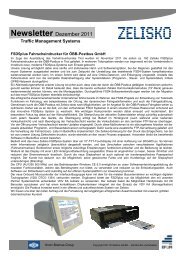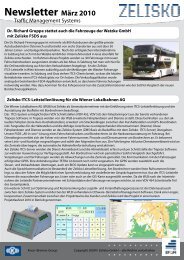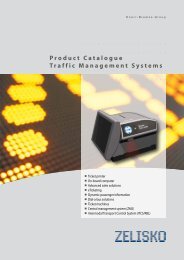Annual Report 2012 - Knorr-Bremse AG.
Annual Report 2012 - Knorr-Bremse AG.
Annual Report 2012 - Knorr-Bremse AG.
Create successful ePaper yourself
Turn your PDF publications into a flip-book with our unique Google optimized e-Paper software.
32<br />
implicit in the changing state of the global economy. The<br />
development of the economies of individual countries<br />
and the worldwide flow of trade are carefully monitored<br />
in order to minimize risks affecting the company‘s sales.<br />
At the same time, <strong>Knorr</strong>-<strong>Bremse</strong>’s international presence<br />
renders the Group largely immune to risks that are restricted<br />
to an individual region. The increased volatility<br />
being encountered worldwide in the commercial vehicle<br />
industry also affects <strong>Knorr</strong>-<strong>Bremse</strong> and continues to be<br />
carefully monitored. If customer creditworthiness falls,<br />
the risk of the loss of receivables outstanding increases<br />
and <strong>Knorr</strong>-<strong>Bremse</strong> counters this risk through effective receivables<br />
management.<br />
In the course of its dynamic growth in recent years, <strong>Knorr</strong>-<br />
<strong>Bremse</strong> has integrated a number of companies or shareholdings<br />
into the Group. The financial and cultural risks<br />
typically associated with such integration processes were<br />
effectively minimized by means of systematic analysis<br />
and assessment of the target companies. When it comes<br />
to overcoming cultural barriers, <strong>Knorr</strong>-<strong>Bremse</strong> can draw<br />
on 20 years of experience with integration processes related<br />
to the acquisition of numerous companies as well as<br />
to joint ventures in which the company holds a majority<br />
stake and is responsible for operational management.<br />
This experience will pay dividends in any future mergers<br />
and acquisitions and has been mapped in the form of<br />
structured processes.<br />
<strong>Knorr</strong>-<strong>Bremse</strong> and its systems are at the leading edge of<br />
technological development. This also engenders risks<br />
which, because of the safety-critical nature of the applications<br />
concerned, require particularly careful monitoring.<br />
To this end, <strong>Knorr</strong>-<strong>Bremse</strong> routinely employs comprehensive<br />
quality planning, quality assurance and testing<br />
procedures. To ensure continuous improvement of its<br />
business processes, <strong>Knorr</strong>-<strong>Bremse</strong> takes its lead from<br />
international standards. The individual plants regularly<br />
undergo internal and external audits in this context.<br />
Above and beyond this, despite having already attained a<br />
very high level of quality, both divisions work intensively<br />
to continuously improve the quality and reliability of their<br />
products with the aid of the <strong>Knorr</strong> Excellence quality program<br />
“Quality First”.<br />
Operational risks<br />
Risks due to production downtimes are covered by commercially<br />
appropriate insurance contracts. Flexible working<br />
time models enable unexpected short-term shifts in<br />
capacity requirements to be accommodated efficiently.<br />
<strong>Knorr</strong>-<strong>Bremse</strong> maintains a close working relationship with<br />
suppliers and service providers. In order to avoid delivery<br />
delays or quality defects, which in turn could lead to lost<br />
production time and have a negative impact on earnings,<br />
<strong>Knorr</strong>-<strong>Bremse</strong> attaches great importance to careful supplier<br />
selection procedures. Suppliers are also continuously<br />
subjected to technical and commercial audits. In the<br />
current economic environment, there is also a risk of business<br />
partners becoming insolvent – a risk to which the<br />
company responds directly.<br />
On the customer side, particularly in the original equipment<br />
segment, it can happen that, due to the expiry of<br />
long-term price agreements and the longer-than-expected<br />
duration of follow-up negotiations, for a restricted period<br />
shipments are made without a valid supply agreement<br />
in place. This can lead to price differences and the<br />
associated risks. Moreover, contractual obligations can<br />
lead to warranty risks. Systematic contract management<br />
to control these risks is ensured by appropriate <strong>Knorr</strong> Excellence<br />
processes.<br />
Exchange rate risk is not of crucial importance for the<br />
<strong>Knorr</strong>-<strong>Bremse</strong> Group because geographic diversification<br />
over recent years has enabled the Group to establish a<br />
high proportion of local manufacturing and local suppliers<br />
within the respective currency zones. In order to limit<br />
the residual exchange rate risk related to transactions<br />
across different currency zones, <strong>Knorr</strong>-<strong>Bremse</strong> is increasingly<br />
identifying opportunities to exploit compensatory



![1 Newsletter 2013 Version 0 92 [Kompatibilitätsmodus] - Zelisko](https://img.yumpu.com/50939577/1/184x260/1-newsletter-2013-version-0-92-kompatibilitaatsmodus-zelisko.jpg?quality=85)




![Backofficelösung ZMS [PDF, 740 kB] - Zelisko](https://img.yumpu.com/33964695/1/184x260/backofficelaasung-zms-pdf-740-kb-zelisko.jpg?quality=85)

![Geschäftsbericht 2012 [PDF, 13 MB] - Zelisko](https://img.yumpu.com/31517535/1/184x260/geschaaftsbericht-2012-pdf-13-mb-zelisko.jpg?quality=85)


![Produktkatalog Gesamtlösungen [PDF, 4 MB] - Zelisko](https://img.yumpu.com/22973479/1/182x260/produktkatalog-gesamtlaasungen-pdf-4-mb-zelisko.jpg?quality=85)
![ITCS Datenblatt [PDF, 804 kB] - Zelisko](https://img.yumpu.com/22855155/1/184x260/itcs-datenblatt-pdf-804-kb-zelisko.jpg?quality=85)
![Fahrscheindrucker FSD5plus [PDF, 934 kB] - Zelisko](https://img.yumpu.com/22822643/1/184x260/fahrscheindrucker-fsd5plus-pdf-934-kb-zelisko.jpg?quality=85)
